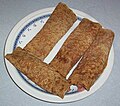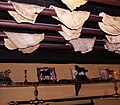Oatcake
Oatcake is a type of flatbread similar to a cracker or biscuit, or in some versions takes the form of a pancake. They are prepared with oatmeal as a primary ingredient, and are sometimes enriched with other ingredients such as wheat.
History[edit]
The oatcake has a long history in Scotland, England and Ireland where oats have been a staple grain for centuries. The first recorded mention of oatcakes dates back to 1st century AD in Roman Britain. They were traditionally baked on a griddle or baked in an oven.
Varieties[edit]
There are many regional varieties of oatcakes. In Scotland, the Scottish oatcake is a popular type, often served with meals or as a snack. In England, the Staffordshire oatcake is a regional specialty of the Staffordshire area. It is a type of pancake made with oatmeal, flour and yeast. In Canada, the Acadian oatcake is a traditional dish of the Acadian people.
Preparation[edit]
Oatcakes are typically made by mixing oatmeal with a liquid such as water or milk and then adding salt. The mixture is then rolled out and cut into rounds. The rounds are then baked until crisp. Some recipes may also include sugar, baking powder, or other ingredients.
Nutritional Value[edit]
Oatcakes are high in fiber and can be a good source of slow release energy due to the complex carbohydrates in the oats. They can also be a good source of protein, especially when made with milk.
Cultural Significance[edit]
Oatcakes have a significant cultural importance in Scotland, where they are often served with meals or as a snack. They are also traditionally eaten on Burns Night, a celebration of the life and poetry of the poet Robert Burns.
See Also[edit]
-
Oatcake
-
Making oat cakes - The costume of Yorkshire (1814)
-
Oatcakes
-
Oat cakes in the Beamish Museum
-
Girdledalgarven
-
Oatcakes Trangia
-
Clapshot and oatcakes
-
Oat cakes, Ulster American Folk Park
Ad. Transform your life with W8MD's Budget GLP-1 injections from $75


W8MD offers a medical weight loss program to lose weight in Philadelphia. Our physician-supervised medical weight loss provides:
- Weight loss injections in NYC (generic and brand names):
- Zepbound / Mounjaro, Wegovy / Ozempic, Saxenda
- Most insurances accepted or discounted self-pay rates. We will obtain insurance prior authorizations if needed.
- Generic GLP1 weight loss injections from $75 for the starting dose.
- Also offer prescription weight loss medications including Phentermine, Qsymia, Diethylpropion, Contrave etc.
NYC weight loss doctor appointmentsNYC weight loss doctor appointments
Start your NYC weight loss journey today at our NYC medical weight loss and Philadelphia medical weight loss clinics.
- Call 718-946-5500 to lose weight in NYC or for medical weight loss in Philadelphia 215-676-2334.
- Tags:NYC medical weight loss, Philadelphia lose weight Zepbound NYC, Budget GLP1 weight loss injections, Wegovy Philadelphia, Wegovy NYC, Philadelphia medical weight loss, Brookly weight loss and Wegovy NYC
|
WikiMD's Wellness Encyclopedia |
| Let Food Be Thy Medicine Medicine Thy Food - Hippocrates |
Medical Disclaimer: WikiMD is not a substitute for professional medical advice. The information on WikiMD is provided as an information resource only, may be incorrect, outdated or misleading, and is not to be used or relied on for any diagnostic or treatment purposes. Please consult your health care provider before making any healthcare decisions or for guidance about a specific medical condition. WikiMD expressly disclaims responsibility, and shall have no liability, for any damages, loss, injury, or liability whatsoever suffered as a result of your reliance on the information contained in this site. By visiting this site you agree to the foregoing terms and conditions, which may from time to time be changed or supplemented by WikiMD. If you do not agree to the foregoing terms and conditions, you should not enter or use this site. See full disclaimer.
Credits:Most images are courtesy of Wikimedia commons, and templates, categories Wikipedia, licensed under CC BY SA or similar.
Translate this page: - East Asian
中文,
日本,
한국어,
South Asian
हिन्दी,
தமிழ்,
తెలుగు,
Urdu,
ಕನ್ನಡ,
Southeast Asian
Indonesian,
Vietnamese,
Thai,
မြန်မာဘာသာ,
বাংলা
European
español,
Deutsch,
français,
Greek,
português do Brasil,
polski,
română,
русский,
Nederlands,
norsk,
svenska,
suomi,
Italian
Middle Eastern & African
عربى,
Turkish,
Persian,
Hebrew,
Afrikaans,
isiZulu,
Kiswahili,
Other
Bulgarian,
Hungarian,
Czech,
Swedish,
മലയാളം,
मराठी,
ਪੰਜਾਬੀ,
ગુજરાતી,
Portuguese,
Ukrainian








